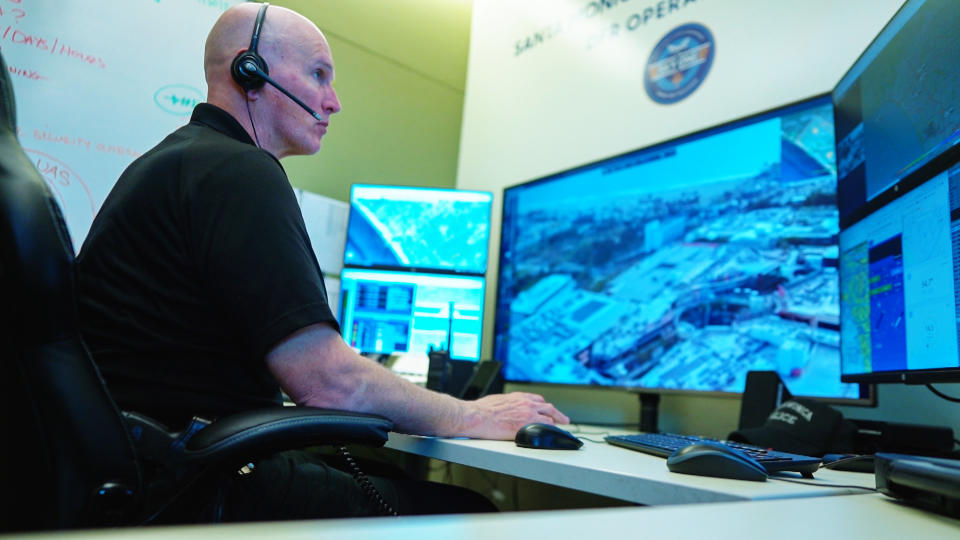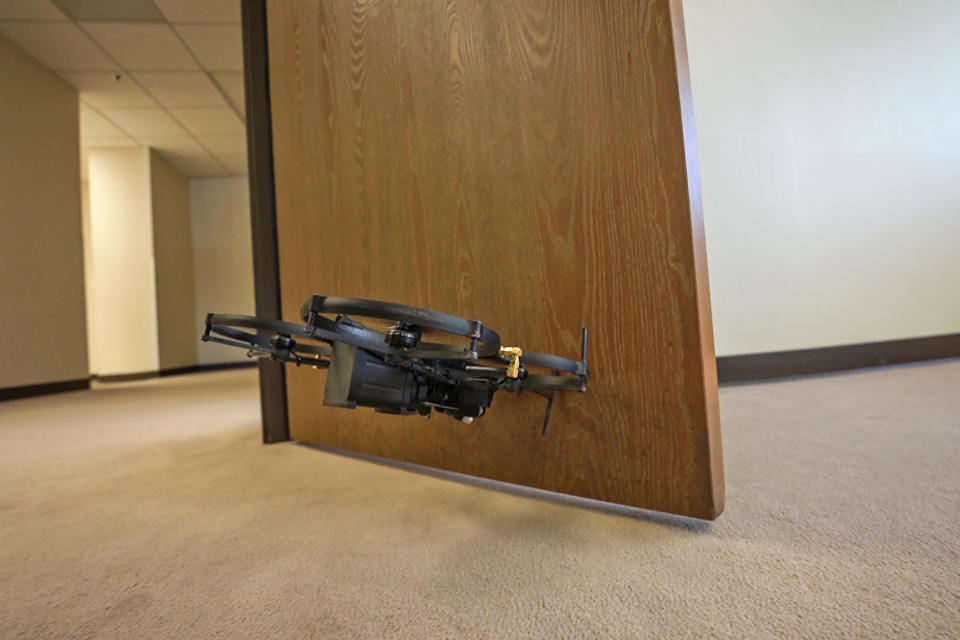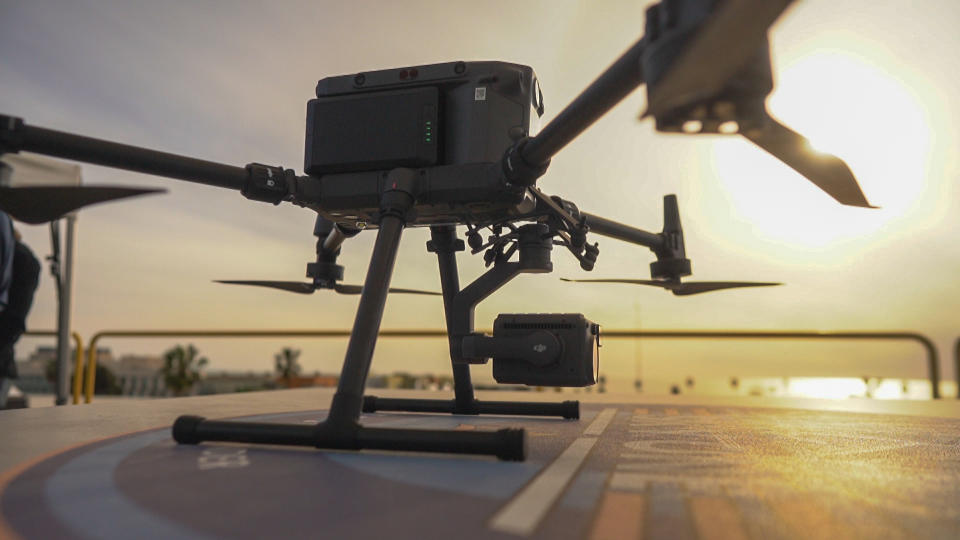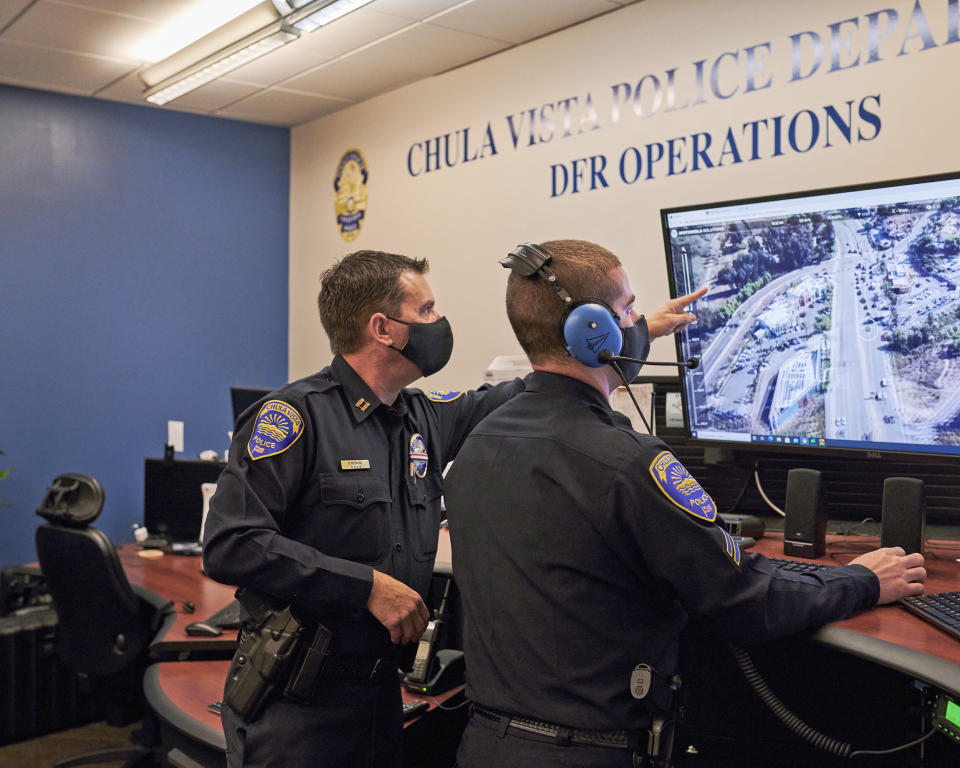In this beach town, sometimes the first cop on the scene is a drone
When someone calls 911 for police in the upscale beach town of Santa Monica, California, a drone is dispatched from the roof of the station with a push of a button.
Officers respond, as well. But most of the time, the drone gets there first — rushing to a set of GPS coordinates punched in by the controller. Sometimes it is there in as fast as 30 seconds.
“It’s a fundamental change in the way that we can bring policing services to our city,” said Peter Lashley, a veteran of the force who often pilots the drone from a screen-filled command center inside the police station.
The drone’s powerful camera can provide a view of several square blocks, or it can zoom in close enough to read a license plate. In Santa Monica, the drone camera was the only witness to a brutal robbery, and one of two suspects was apprehended and convicted. On at least three occasions, it provided responding officers with critical, otherwise unobtainable information — that what looked like guns in the hands of subjects were not real firearms. That insight allowed officers to respond much less aggressively.
At a time when law enforcement agencies face a crisis of legitimacy amid a series of high-profile murder cases against officers, police say drones could make a huge impact by defusing potentially violent situations. Their proliferation is also likely to prompt fears about risks to privacy and a renewed debate about the balance of power between ordinary people and their government.

But in Southern California, the police officials who have implemented what is known as the “drones as first responder” program say residents and political leaders have been supportive, because they do not use the drones to hover over neighborhoods, hunting for crime. The courts have found that blanket aerial police surveillance over an entire city is unconstitutional.
“We respond to 911 calls for service,” said Lashley, a former art director at a Chicago advertising agency. “We don’t randomly fly over the city looking for people doing anything wrong.”
He added: “This technology is in its infancy. It is developing. It’s such a game changer. … For us, breaking the faith, using it irresponsibly — any benefit that we would get will never outweigh the benefits that it gives us.”
Police have long dabbled with drones, but using them to respond to 911 calls is relatively new and rare. The first-responder program got its start in 2018 in Chula Vista, near San Diego, where drones can cover the entire city after officials obtained a waiver from the Federal Aviation Administration to fly outside a pilot’s line of sight. Over the past two years, the program has spread rapidly around Los Angeles — Beverly Hills and Redondo Beach have adopted it, in addition to Santa Monica, as have a dozen or so other departments nationwide. The Los Angeles Police Department, which operates a fleet of helicopters, does not use drones for 911 calls — although officials there say they use them in limited circumstances in tactical situations.
Tactical drone use is also expanding as the technology improves. NBC News got a demonstration of the Lemur, a hardened quadcopter that can break glass, push open doors, fly into buildings and allow police to talk to barricaded subjects in hostage situations. Santa Monica is not yet using one, but many other departments are.
The Lemur is made by BRINC, a company founded in 2017 by Blake Resnick, then 17, prompted by the mass shooting in his hometown, Las Vegas.

“What we found in tactical situations is if we can communicate with a person, we can de-escalate it much quicker and bring the situation to resolution,” said Don Redmond, a retired Chula Vista police officer who now works for BRINC. “But we also deployed it during the Surfside condo collapse in Florida to look for people that were trapped inside the building.”
Jay Stanley, who has examined government drone use as a senior policy analyst with the American Civil Liberties Union in Washington, says his organization does not oppose deploying drones to respond to emergencies or in hostage situations.
“Our position is it’s legitimate for police departments to use drones to find a lost kid in the woods, for raids, accidents, crime scenes,” he said.
But police use of drones raises “all the same questions body cameras raise,” he said. “What happens to the footage? Who gets access to it? Are the police going to release the footage when it makes them look heroic and bury it when it doesn’t?”
Police have sought to address those concerns. Departments prohibit operators from recording video over private homes or other places where people would have a reasonable expectation of privacy, except in emergencies or pursuant to warrants. Chula Vista publishes the flight paths for every drone mission on its website. Santa Monica officials say they destroy all video after 60 days unless it is being used as evidence or is needed for an investigation.
Police say they have informally shown drone camera video to anyone expressing concern, although California departments have taken the position that the video is not releasable under public records laws. That premise is being challenged in a lawsuit against Chula Vista by La Prensa San Diego, a bilingual Latino newspaper.
A persistent eye in the sky could give a huge boost to police in solving street crimes, particularly in neighborhoods where witnesses tend not to cooperate. But it would also give the government terabytes of data on the movements of everyone, and courts so far have deemed that an unacceptable invasion of privacy.

In 2021, a program in Baltimore in which the police conducted persistent aerial surveillance using cameras mounted to planes was ruled unconstitutional by a federal appeals court, which said it violated the Fourth Amendment’s protection against unreasonable search and seizure.
The 8-7 decision drew a stinging dissent from the minority, which said the damage from crime outweighed the potential privacy issues. By then, the Baltimore program had already ended, so the case never reached the Supreme Court.
Drones responding to emergency calls do not pose the same constitutional concerns, experts say. The greatest benefit is “the situational awareness,” Lashley said. “It allows an experienced police officer to see what’s going on in real time and communicate those facts to the officers responding and give them that perspective of what to expect, rather than going in with just the information of a phone call.”
In Chula Vista, drone operators listen in to 911 calls and can send their aircraft based on information learned during the calls, even before police are dispatched, officials said.

Often, the biggest beneficiary is the target of a police encounter. Last year, Santa Monica got a 911 call about a man with a pistol in a drugstore parking lot. As officers sped to the scene, the drone flew overhead and at first appeared to confirm the man had a firearm.
But moments later, Lashley said as he showed the video to NBC News, “I can clearly see — and you’ll see him exhale, there’s a little bit of smoke here in a second — that I’m 99% sure that that’s some type of lighter.”
That allowed an officer on foot to approach the man without concern that his life was in danger, which changed the nature of the encounter. A similar situation unfolded in Santa Monica when a group of teenagers appeared to be passing around two handguns in a main shopping area across from the beach, as seen in the drone video.
“The drone got there,” Lashley said. “We identified that, indeed, they had guns, [but] as we watched them, we determined those guns were actually airsoft BB guns. We were able to communicate that. It de-escalated the situation, and it went from a violent felony in progress to … a group of teenagers clowning around.”
Some of the worst incidents of police violence in recent years “were the result of police going into a situation with limited information,” said Santa Monica’s mayor, Gleam Davis, a Democrat who once worked in the Justice Department’s Civil Rights Division. “The drone really lets us do a much better assessment of the situation on the ground.”
Proponents of police drones often cite the example of 12-year-old Tamir Rice, whom Cleveland police shot and killed in 2014 after he was seen playing with a pellet gun. A drone overhead could have allowed responding officers to understand he was not a threat, they say.
Chula Vista and Santa Monica police say they have used drones to peer through the front windshields of vehicles during traffic stops, reducing the chances of overreactions by officers approaching from behind with limited visibility.
Fire departments also have access to the drones that respond to 911 calls and have used them to better understand fires and spills involving hazardous materials.
According to data from the drone maker DJI, more than 1,000 people in 39 countries have been rescued from danger by drones. DJI lists rescues from around the world on the DJI Drone Rescue Map, which tracks more than 600 incidents when police, firefighters, rescue squads and bystanders have used drones to save people from danger since the first known rescue in 2013.
But DJI, the leading brand for consumer and commercial drones, is itself a thorny issue. The Defense Department blacklisted DJI, a Chinese-owned company, last fall as a “potential national security threat” amid concerns that data from the drones can be shared with the Chinese government. DJI disputes that it poses any threat.
The U.S. has not banned state and local governments from using DJI drones.
“We absolutely appreciate as best we can that there are national security concerns,” Lashley said, but “we don’t have any military bases. We don’t have, as far as I know, any secret sites in Santa Monica.”
Drones often give the police more time to make decisions, and time can save lives, Redondo Police Capt. Stephen Sprengel said.
“It’s an incredible resource that’s going to potentially reduce risk and liability and ultimately make policing safer for not only the community but also for the officer,” he said. “It’s amazing what you can see from the air.”
This article was originally published on NBCNews.com

